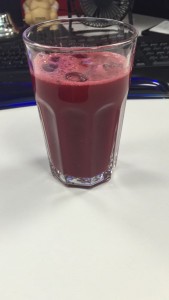Posted on November 25, 2016 by Kate Halsall
This juice contains 1x beetroot, 4x apples, 4x carrots, 1/2x lemon and a bit of ginger.
We’ve written a number of blogs regarding juicing but this one will be a little different. The problems with juice diets is that we are all told so many different things it’s hard to know what to believe. So rather than going through listing pros and cons again (see previous blogs on this subject), “what’s in the pulp” takes a hard look at what you might not realise is or isn’t in those juices.
What’s In The Juice?
- At least your “5 a day” of fruit and veg – if not more!
- The same amount of vitamins and minerals and healthy natural chemicals produces by plants as eating the things whole. What’s more, because it is juiced, it’s easier to digest this goodness.
- Calories. Surely it’s low calorie I hear you ask? In the most part it will be – but different fruit and veg have different calories. In the juice that is pictured above, are 544 calories. Wow!
- Carbohydrates and Sugar. You’ll argue with me now that it’s natural sugar so it’s ok. But the sugars are released quickly through juicing which can increase your glycemic load and spike your bodies blood sugar levels and ultimately, can promote fat storage. Lets go back to the juice pictured above; it contains 141g of carbs and of those carbs, 96.1g of them are sugars. So almost 70% of the juice is sugar…eek.
- Protein. Yes, fruit and vegetables contain protein. In this juice there are 6.8g protein. You can of course increase the amount of protein depending on what fruit and veg you are juicing.
Here’s my caveat – the numbers provided here for calories, carbohydrates, sugars and protein are based on the fruit and vegetables dry weight – so in their non juiced form. Does juicing reduce or remove the amount of carbs or calories or protein or sugars…………read the next section!
What’s In The Pulp?
- Fibre. The pulp consists largely of insoluble fibre. This is the food stuffs that helps to regulate your blood sugar levels by controlling the release of sugar to your body, it helps promote good bacteria in your gut and intestines, it helps to control your digestive health and can help to reduce the risk of diabetes and heart disease.
Yep that’s it folks – the pulp is just the fibrous parts of the fruit and veg. To make sure you get all the goodness you can from your juices, you should be using the pulp too! There’s an astonishing amount of websites dedicated to “pulp” recipes!
Hopefully this blog has helped you to understand what’s in a juice more and whether juicing is suitable. They can be a great way to supplement your diet, but don’t think for a second that just because something is juiced that it’s low carb or better for you!
http://edition.cnn.com/2014/04/11/health/juicing-pros-cons/
http://www.telegraph.co.uk/men/active/mens-health/11632866/Is-juicing-really-good-for-you.html
https://www.nutrition.org.uk/healthyliving/basics/fibre.html
https://draxe.com/juice-cleanse/
http://www.prolificjuicing.com/use-juice-pulp/
http://www.livestrong.com/article/311860-calorie-count-for-juicing-fruits-vegetables/
http://www.nhs.uk/chq/pages/1139.aspx?categoryid=51


